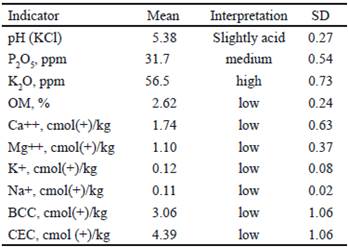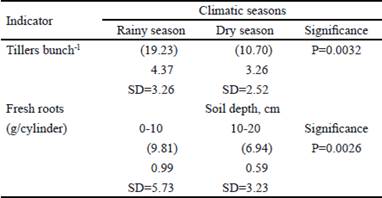In several researches conducted in Cuba (Lok et al. 2010, 2013 and Crespo and Martínez, 2016) the evolution of the general soil fertility has been studied with the biomass bank technology in the CUBA CT-115 grass, applied during a prolonged time in different locations in Cuba. In these studies, diverse performances between soil types and climatic conditions were found.
This research, which is a continuation of the previous ones, aimed to study the changes that showed the chemical, physical and biological properties of a carbonate red brown soil in the area of a CUBA CT-115 bank, grazed by dairy cows for 10 consecutive years.
Materials and Methods
The total area of grasslands from La Jíbara dairy is 100 ha, of which 13.4 ha (13.4 %) were occupied by the biomass bank of Cenchrus purpureus (Cenchrus purpureus (schumach) Morone cv. Cuba CT-115), while 84.4% Guinea grass likoni (Megathyrsus maximus (Jacq.) B.K. Simon & S.W.L. Jacobs, and 3 % shrub Leucaena (Leucaena leucocephala Lin. cv. Peru).
The biomass bank used in rotational grazing for 10 consecutive years is located north of the Central Highway and south of the management of the cattle enterprise "Camilo Cienfuegos", in Pinar del Río province. For this study, an area of 5 ha was selected, divided into five paddocks, of 1ha each.
The soil that predominates in this scenario is carbonate red brown (Hernández et al.2015), with slight differences in terms of texture and effective depth.
Some chemical characteristics of this soil at the beginning of the bank establishment are shown in table 1. The reaction of this soil is slightly acidic, with medium P2O5 and high K2O content, and very low base change capacity. Among the interchangeable cations, Ca++ predominates.
Table 1 Chemical characteristics of the carbonate red brown soil in the biomass bank of the dairy unit "La Jíbara", 10 years before to start this research.

Initially, the herd of the dairy was constituted by 115 cows, 2 bulls, 60 heifers and 45 calves, for an estimated stocking rate of 1.7 UGM / ha. The information regarding the productions and performance of the animals was not obtained at the beginning of the management of the biomass bank.
Experimental procedure. In 2013, an area of 5.0 ha from the CT-115 bank exploited for ten consecutive years was selected, which was imaginatively divided into four quadrants for sampling. The undisturbed samples were extracted with cylindrical auger, of 0-15 cm, in five points distributed along the diagonals of each quadrant, for 20 samples in total, similar to the sampling that was made at the beginning, 10 years before.
As it was not possible to determine the apparent density, porosity, compaction and basal respiration indicators in the soil occupied by the biomass bank at the beginning of the research, a sampling at the end of the rainy season of 2014 was carried out, in which they were taken in each one of the areas, five soil samples inside the bank and another five outside the influence of the bank, in depth of 0-15 cm.
The analytical methods used to determine the chemical, physical and biological indicators of the soil were the same cited by Crespo and Martínez (2016).
The plant performance of the biomass bank of CT-115 was determined in each climatic season of the year 2015. In each sampling, five areas of 1m x 1m were randomly taken, in which the number of bunches, the height, the quantity of tillers per plant, the thickness of the central section of the stem and the length of the fourth leaf were counted. The performance of CT-115 was also determined in five rows selected at random by paddock. In each area, the underground phytomass was also evaluated using the methodology proposed by Hernández et al. (1998). This indicator was measured for the depths of 0-15 and 15-30 cm through cylinders of cutting edges of known volume.
To determine the chemical composition of the grass at the end of 2015, the intact samples, consisting of leaves and stems of plants with 90 d of regrowth, were dried in air circulation oven, at alternate temperatures: 100 ºC for one hour and then to 60 ºC until reaching constant weight (around 72 h), according to Herrera (2003). To the samples were determined CP, P and Ca content, according to AOAC (2000), NDF according to van Soest et al. (1991) technique and OM digestibility according to Kesting (1977). All determinations were made in triplicate.
Statistical analysis of the results. The values of the soil indicators were analyzed by variance, according to one-way model. The theoretical assumptions of the analysis of variance were verified for all the variables, from the Shapiro and Wilk (1965) test and the normality of the errors, as well as Levene's (1960) test for the homogeneity of variance. For the analysis of the plant component data, the Fisher's test was applied when the interaction was not significant. When the variables did not comply with the assumptions of the ANAVA, the transformation √x was used. If this did not improve compliance with these assumptions, the nonparametric variance analysis of Kruskal-Wallis was performed. The statistical package used was INFOSTAT (Di Rienzo et al.2012).
Results and Discussion
The chemical soil indicators in the biomass bank are shown in table 2. There was a significant decrease in pH (P <0.001), assimilable P2O5 (P = 0.016), assimilable K2O (P <0.001), exchangeable Mg++ (P<0.001), base change capacity BCC (P = 0.002) and cation-exchange capacity CEC (P = 0.006). The OM significantly increased (P = 0.004), while interchangeable Ca++, Na+ and K+ were not affected.
Although the soil OM showed a significant increase after 10 years of grazing, this value is still interpreted as low. However, the increase of 10.7 % could be due to the continuous accumulation of litter by the plants of CT-115, also reported by Lok et al. (2010) and Crespo (2011) in other types of soil
The grassland systems that allow the increase of OM content in the soil are a very important topic, since they make possible the increase of the C capture in the soil, with the consequent improvement in the environment and in the general fertility of the soil (Venden Bygaart et al. 2010 and Lok et al. 2013).
For a long time, the importance of soil organic matter (SOM) in the maintenance of its quality is recognized (Crespo 2011 and Stockmann et al. 2013), mainly as regards the improvement of its chemical and physical properties and, to a large extent, in the existence of a rich and diversified biota (Baum et al.2013).
In relation to this, models for the estimation of organic soil carbon storage (OSC) in agricultural areas are often used (Lugato et al. 2014) and the ratio of humic acids / fulvic acids (HA / FA) is also identified. in the OSC.
A long-term research, conducted by Horacek et al. (2017), showed that in Chernozem soils, from several regions of Czechoslovakia, the current SOM quantity was significantly higher than 50 years earlier, but the HA / FA ratio was lower. This shows that the higher accumulation of SOM compensated the decrease of its quality in this type of soil.
The studies conducted by Lou et al. (2010) showed a wide range of OSC in the grasslands of eastern Australia, which varied between 22.4 - 66.3 t/ha at the depth of 0-30 cm. These authors propose to conduct long-term research to know exactly how it occurs and in what amount the sequestration of C in the soil under grasslands and how influence the management practices.
The results also indicated that it will be necessary to pay close attention to the early supply of a phosphorus carrier that allows maintaining the biomass bank productivity. The chemical analysis showed, in addition, significant decrease of K in the soil.
This fact may be due, in part, to the high extraction of this element by plants belonging to the Cenchrus purpureus genus (Herrera and Ramos, 2005).
The low resilience power shown by this soil was notorious, where practically all the chemical indicators studied (except Ca, Na and K) decreased significantly in the tenth year of exploitation. It is very likely that the low CEC has been the main cause of this performance, since they can cause appreciable losses of ions by leaching (Hernández et al. 2015). The performance shown by this soil alerts on the need to supply early sources of nutrients that compensate such decreases and help maintain the productivity of the CT-115 bank.
The determination of some physical soil variables in the area occupied by the biomass bank, compared with the adjacent area dedicated to the mechanized production of forage, is shown in table 3. In the soil occupied by the biomass bank, the compaction was significantly lower, and the porosity and basal respiration were higher with respect to the soil outside the bank. This shows that the intensive mechanization of forage also deteriorates the stability of some physical factors of importance in the soil (Cuenca 2014).
These results give an idea of the low resilience capacity of this soil, which worsens when the forage area is exploited with continued use of cutting machines. In this sense, the loam-clay-sandy texture of this soil makes it, to a certain degree, susceptible to the sensitive losses of many of its chemical indicators (Jaramillo 2002).
The low values of BCC and of the CEC of the soil give an idea of the poor capacity of the soil to retain nutrients and, therefore, of their susceptibility to lose them as frequent grazing for 10 consecutive years were made.
Neither the biomass of the macrofauna nor the number of earthworms per stratum significantly varied with the depth of the soil.
The tillers/ bunch indicator showed lower value (P = 0.0032) in the dry season (table 4). This decrease in tillering in the dry season seems to have been the main cause of the lower value of grass performance at that season of the year. The biomass of grass roots was significantly higher in the depth of 0-10 cm, compared to the surface layer of 0-10 cm. Apparently, the absence of an argillic clay material in this soil hindered the penetration of the grass roots at higher depth (Ventury and Keel 2016 and Vetterlein and Doussan 2016).
The CP, P, Ca, NDF values and digestibility of the CT-115 grass in the dry season of 2014 are shown in table 5.
The decrease found in the indicators of chemical soil fertility was also reflected in the decrease of some of the indicators of the chemical composition of CT-115. Thus, the sampling conducted in the dry season of 2015, showed that the CP did not exceed the concentration of 75 g kg-1, while the phosphorus showed values lower than 1.2 g kg-1. In turn, the NDF was higher than 50% and DM digestibility was showed in values lower than 42 %. Values similar to these indicators were also indicated by Valenciaga et al. (2009), but with advanced ages of growth of this grass.
It is concluded that this carbonate red brown soil showed low resilience power, with a significant decrease in pH and the contents of P, K and Mg in the bank that has 10 years of uninterrupted grazing. This decrease in soil fertility indicators was also reflected in the decrease in the CP, P and Ca contents, as well as in the CT-115 digestibility.
These results warn about the need to supplement with sources of protein, phosphorus and calcium to the animals that grazed in this bank to achieve an adequate balance in their diet.











 texto en
texto en 






